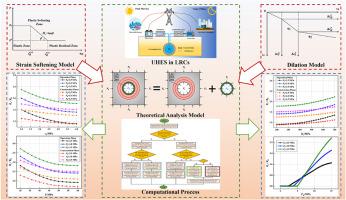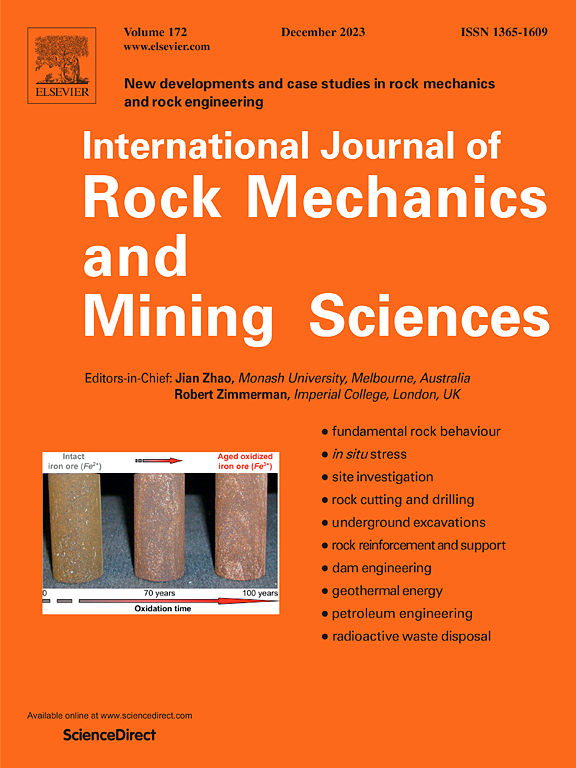An elastoplastic solution for lined hydrogen storage caverns during excavation and operation phases considering strain softening and dilatancy
IF 7
1区 工程技术
Q1 ENGINEERING, GEOLOGICAL
International Journal of Rock Mechanics and Mining Sciences
Pub Date : 2024-10-29
DOI:10.1016/j.ijrmms.2024.105949
引用次数: 0
Abstract
Underground hydrogen energy storage (UHES) in lined rock caverns (LRCs) represents a crucial solution to the challenge of unstable and uneven clean energy generation. Nevertheless, the attainment of enhanced storage efficiencies frequently necessitates the utilization of elevated hydrogen storage pressures. Consequently, a comprehensive understanding of the elastic-plastic mechanical response of surrounding rock under hydrogen pressure is of paramount importance for ensuring the safety of UHES. In this study, an elastoplastic solution of LRCs during construction and operation phases is established. Two essential phenomena affecting the post-peak mechanical responses of surrounding rock, strain softening and dilatancy, are coupled into the plastic solution. A computational process is developed and its accuracy is validated through comparison with numerical models. The influence of surrounding rock quality parameters, strain softening and dilatancy parameters, concrete quality parameters and hydrogen pressure on the radius of the plastic softening zone (Rs) and plastic residual zone (Rr) were analyzed. Results show that higher surrounding rock quality can effectively reduce both Rs and Rr. Nevertheless, when the surrounding rock quality already reaches a high standard, such as c1 > 3.5 MPa, φ1 > 65°, or E > 55 MPa, it becomes inefficient to overly pursue further improvements in the surrounding rock quality. Furthermore, the strain softening and dilatancy phenomena only affect Rr. Additionally, the concrete lining with higher stiffness can share a larger portion of the hydrogen pressure, thus reducing both Rs and Rr. Notably, When the elastic modulus of concrete increases from 20 MPa to 40 MPa, Rr decreases by 31.98 % and Rs decreases by 20.96 %. Moreover, the critical hydrogen pressure (PHcr) at which the surrounding rock begins to enter a plastic state is proportional to the ground stress (P0). Specifically, when P0 is increased sequentially from 2.5 MPa to 3.0 MPa and 3.5 MPa, PHcr sequentially becomes 2.4 MPa, 4.0 MPa, and 5.0 MPa. The findings presented in this study contribute to improving the safety of LRCs during construction and operation.

考虑到应变软化和扩张的内衬储氢洞在挖掘和运行阶段的弹塑性解决方案
内衬岩洞(LRCs)中的地下氢能储存(UHES)是解决清洁能源发电不稳定和不均匀难题的重要方法。然而,要实现更高的储氢效率,往往需要利用更高的储氢压力。因此,全面了解氢压下围岩的弹塑性机械响应对于确保超高压储氢系统的安全性至关重要。本研究建立了 LRC 在施工和运行阶段的弹塑性解决方案。影响围岩峰值后机械响应的两个基本现象--应变软化和膨胀--被耦合到塑性解决方案中。开发了一种计算程序,并通过与数值模型的比较验证了其准确性。分析了围岩质量参数、应变软化和膨胀参数、混凝土质量参数和氢压力对塑性软化区(Rs)和塑性残余区(Rr)半径的影响。结果表明,围岩质量越高,Rs 和 Rr 越小。然而,当围岩质量已经达到较高标准时,如 c1 > 3.5 MPa、φ1 > 65° 或 E > 55 MPa,过分追求围岩质量的进一步提高就会变得效率低下。此外,应变软化和膨胀现象只影响 Rr。此外,刚度较高的混凝土衬砌可以分担较大部分的氢压力,从而降低 Rs 和 Rr。值得注意的是,当混凝土的弹性模量从 20 兆帕增加到 40 兆帕时,Rr 减少了 31.98%,Rs 减少了 20.96%。此外,围岩开始进入塑性状态的临界氢压力 (PHcr) 与地应力 (P0) 成正比。具体来说,当 P0 从 2.5 兆帕依次增加到 3.0 兆帕和 3.5 兆帕时,PHcr 依次变为 2.4 兆帕、4.0 兆帕和 5.0 兆帕。本研究的结果有助于提高喇嘛研究中心在施工和运行期间的安全性。
本文章由计算机程序翻译,如有差异,请以英文原文为准。
求助全文
约1分钟内获得全文
求助全文
来源期刊
CiteScore
14.00
自引率
5.60%
发文量
196
审稿时长
18 weeks
期刊介绍:
The International Journal of Rock Mechanics and Mining Sciences focuses on original research, new developments, site measurements, and case studies within the fields of rock mechanics and rock engineering. Serving as an international platform, it showcases high-quality papers addressing rock mechanics and the application of its principles and techniques in mining and civil engineering projects situated on or within rock masses. These projects encompass a wide range, including slopes, open-pit mines, quarries, shafts, tunnels, caverns, underground mines, metro systems, dams, hydro-electric stations, geothermal energy, petroleum engineering, and radioactive waste disposal. The journal welcomes submissions on various topics, with particular interest in theoretical advancements, analytical and numerical methods, rock testing, site investigation, and case studies.

 求助内容:
求助内容: 应助结果提醒方式:
应助结果提醒方式:


